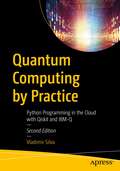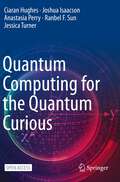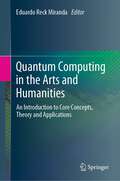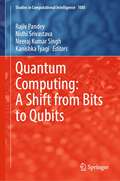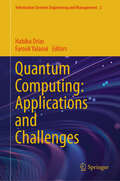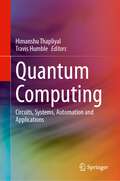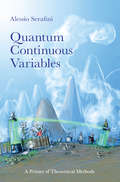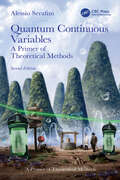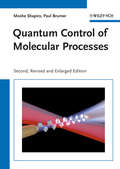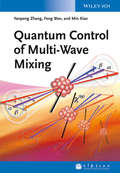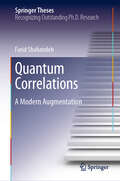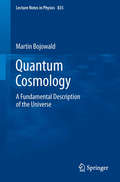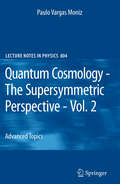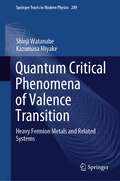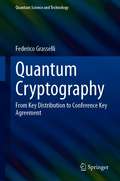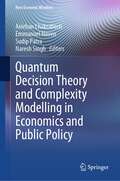- Table View
- List View
Quantum Computing Solutions: Solving Real-World Problems Using Quantum Computing and Algorithms
by Bhagvan KommadiKnow how to use quantum computing solutions involving artificial intelligence (AI) algorithms and applications across different disciplines.Quantum solutions involve building quantum algorithms that improve computational tasks within quantum computing, AI, data science, and machine learning. As opposed to quantum computer innovation, quantum solutions offer automation, cost reduction, and other efficiencies to the problems they tackle.Starting with the basics, this book covers subsystems and properties as well as the information processing network before covering quantum simulators. Solutions such as the Traveling Salesman Problem, quantum cryptography, scheduling, and cybersecurity are discussed in step-by-step detail. The book presents code samples based on real-life problems in a variety of industries, such as risk assessment and fraud detection in banking. In pharma, you will look at drug discovery and protein-folding solutions. Supply chain optimization and purchasing solutions are presented in the manufacturing domain. In the area of utilities, energy distribution and optimization problems and solutions are explained. Advertising scheduling and revenue optimization solutions are included from media and technology verticals. What You Will Learn Understand the mathematics behind quantum computingKnow the solution benefits, such as automation, cost reduction, and efficienciesBe familiar with the quantum subsystems and properties, including states, protocols, operations, and transformationsBe aware of the quantum classification algorithms: classifiers, and support and sparse support vector machinesUse AI algorithms, including probability, walks, search, deep learning, and parallelism Who This Book Is For Developers in Python and other languages interested in quantum solutions. The secondary audience includes IT professionals and academia in mathematics and physics. A tertiary audience is those in industry verticals such as manufacturing, banking, and pharma.
Quantum Computing Strategy: Foundations and Applicability
by Elena YndurainQuantum computing is not merely an incremental advancement in computing technology; it represents a fundamentally new paradigm, distinct from classical computing. Rooted in quantum mechanics, it introduces an entirely novel information theory. As a result, translating existing models, solution designs, and approaches to quantum computing is a complex, non-trivial task. This comprehensive book demystifies quantum concepts through accessible explanations, practical case studies, and real-world examples from industries such as aerospace, agriculture, automotive, chemicals, energy, finance, government, healthcare, manufacturing, supply chain, and telecommunications.Blending a business perspective with a scientific rigor, this book is divided into two parts. The first part covers foundational technical concepts, including quantum mechanics principles that enable quantum technologies, key quantum algorithms, mathematical frameworks, quantum computing technologies, post-quantum cryptography, the types of problems quantum computers solve, and the technology’s outlook. The second part focuses on practical applicability, presenting industry use cases, guidance on approaching quantum computing problems, mapping use cases to quantum computing, responsible quantum computing practices, and a roadmap for businesses preparing for quantum adoption. This structured approach equips readers with the knowledge and tools to effectively integrate quantum computing into their strategic planning.Quantum Computing Strategy: Foundations and Applicability serves as an essential reference for technology enthusiasts, business leaders, policymakers, and educators seeking to understand the benefits quantum computing offers enterprises. Designed as a self-contained learning resource, it empowers readers to navigate the emerging quantum landscape confidently.
Quantum Computing and Other Transformative Technologies (River Publishers Series in Computing and Information Science and Technology)
by Ahmed BanafaThis book explores quantum computing as a transformative technology and its applications in communications, cryptography, teleportation, IoT, AI, and blockchain, in addition to the revolutionary concept of quantum internet. It also explains the concept of dark, small, thick data, and clarifies what the concept of a data lake. Other exciting technologies like edge/fog computing, CDN, SDN, wearable technology and IoE topics are discussed in details in the book. Information security applications like zero trust model, zero-day vulnerability and heuristic analysis, and use of AI in cybersecurity are explored. Two of the most intriguing concepts in computing “affective computing” and “autonomic computing” are explained and simplified. The blockchain applications presented include blockchain and supply chain, crowdsourcing, cryptocurrency, and IoT. The book ends with a look at using technology to fight COVID-19 and future pandemics.
Quantum Computing by Practice: Python Programming in the Cloud with Qiskit and IBM-Q
by Vladimir SilvaLearn to write algorithms and program in the new field of quantum computing. This second edition is updated to equip you with the latest knowledge and tools needed to be a complex problem-solver in this ever-evolving landscape. The book has expanded its coverage of current and future advancements and investments by IT companies in this emerging technology. Most chapters are thoroughly revised to incorporate the latest updates to IBM Quantum's systems and offerings, such as improved algorithms, integrating hardware advancements, software enhancements, bug fixes, and more. You’ll examine quantum computing in the cloud and run experiments there on a real quantum device. Along the way you’ll cover game theory with the Magic Square, an example of quantum pseudo-telepathy. You’ll also learn to write code using QISKit, Python SDK, and other APIs such as QASM and execute it against simulators (local or remote) or a real quantum computer. Then peek inside the inner workings of the Bell states for entanglement, Grover’s algorithm for linear search, Shor’s algorithm for integer factorization, and other algorithms in the fields of optimization, and more. Finally, you’ll learn the current quantum algorithms for entanglement, random number generation, linear search, integer factorization, and others. By the end of this book, you’ll understand how quantum computing provides massive parallelism and significant computational speedups over classical computersWhat You'll LearnWrite algorithms that provide superior performance over their classical counterpartsCreate a quantum number generator: the quintessential coin flip with a quantum twistExamine the quantum algorithms in use today for random number generation, linear search, and moreDiscover quantum teleportationHandle the counterfeit coin problem, a classic puzzle Put your knowledge to the test with more than 150 practice exercises Who This Book Is ForDevelopers, programmers, computer science researchers, teachers, and students.
Quantum Computing for the Quantum Curious
by Jessica Turner Ciaran Hughes Joshua Isaacson Anastasia Perry Ranbel F. SunThis open access book makes quantum computing more accessible than ever before. A fast-growing field at the intersection of physics and computer science, quantum computing promises to have revolutionary capabilities far surpassing “classical” computation. Getting a grip on the science behind the hype can be tough: at its heart lies quantum mechanics, whose enigmatic concepts can be imposing for the novice. This classroom-tested textbook uses simple language, minimal math, and plenty of examples to explain the three key principles behind quantum computers: superposition, quantum measurement, and entanglement. It then goes on to explain how this quantum world opens up a whole new paradigm of computing. The book bridges the gap between popular science articles and advanced textbooks by making key ideas accessible with just high school physics as a prerequisite. Each unit is broken down into sections labelled by difficulty level, allowing the course to be tailored to the student’s experience of math and abstract reasoning. Problem sets and simulation-based labs of various levels reinforce the concepts described in the text and give the reader hands-on experience running quantum programs. This book can thus be used at the high school level after the AP or IB exams, in an extracurricular club, or as an independent project resource to give students a taste of what quantum computing is really about. At the college level, it can be used as a supplementary text to enhance a variety of courses in science and computing, or as a self-study guide for students who want to get ahead. Additionally, readers in business, finance, or industry will find it a quick and useful primer on the science behind computing’s future.
Quantum Computing in the Arts and Humanities: An Introduction to Core Concepts, Theory and Applications
by Eduardo Reck MirandaComputers are essential for the functioning of our society. Despite the incredible power of existing computers, computing technology is progressing beyond today’s conventional models. Quantum Computing (QC) is surfacing as a promising disruptive technology. QC is built on the principles of quantum mechanics. QC can run algorithms that are not trivial to run on digital computers. QC systems are being developed for the discovery of new materials and drugs and improved methods for encoding information for secure communication over the Internet. Unprecedented new uses for this technology are bound to emerge from ongoing research.The development of conventional digital computing technology for the arts and humanities has been progressing in tandem with the evolution of computers since the 1950s. Today, computers are absolutely essential for the arts and humanities. Therefore, future developments in QC are most likely to impact on the way in which artists will create and perform, and how research in the humanities will be conducted.This book presents a comprehensive collection of chapters by pioneers of emerging interdisciplinary research at the crossroads of quantum computing, and the arts and humanities, from philosophy and social sciences to visual arts and music.Prof. Eduardo Reck Miranda is a composer and a professor in Computer Music at Plymouth University, UK, where he is a director of the Interdisciplinary Centre for Computer Music Research (ICCMR). His previous publications include the Springer titles Handbook of Artificial Intelligence for Music, Guide to Unconventional Computing for Music, Guide to Brain-Computer Music Interfacing and Guide to Computing for Expressive Music Performance.
Quantum Computing since Democritus
by Scott AaronsonWritten by noted quantum computing theorist Scott Aaronson, this book takes readers on a tour through some of the deepest ideas of maths, computer science and physics. Full of insights, arguments and philosophical perspectives, the book covers an amazing array of topics. Beginning in antiquity with Democritus, it progresses through logic and set theory, computability and complexity theory, quantum computing, cryptography, the information content of quantum states and the interpretation of quantum mechanics. There are also extended discussions about time travel, Newcomb's Paradox, the anthropic principle and the views of Roger Penrose. Aaronson's informal style makes this fascinating book accessible to readers with scientific backgrounds, as well as students and researchers working in physics, computer science, mathematics and philosophy.
Quantum Computing: A Shift from Bits to Qubits (Studies in Computational Intelligence #1085)
by Neeraj Kumar Singh Rajiv Pandey Nidhi Srivastava Kanishka TyagiThe edited book is a consolidated handbook on quantum computing that covers quantum basic science and mathematics to advanced concepts and applications of quantum computing and quantum machine learning applied to diverse domains. The book includes dedicated chapters on introduction to quantum computing, its practical applications, the working behind quantum systems, quantum algorithms, quantum communications, and quantum cryptography. Each challenge that can be addressed with quantum technologies is further discussed from theoretical and practical perspectives. The book is divided into five parts: Part I: Scientific Theory for Quantum, Part II: Quantum Computing: Building Concepts, Part III: Quantum Algorithms- Theory & Applications, Part IV: Quantum Simulation Tools & Demonstrations, and Part V: Future Direction and Applications.
Quantum Computing: Applications and Challenges (Information Systems Engineering and Management #2)
by Farouk Yalaoui Habiba DriasThis book is intended for academics, researchers, Ph.D. students, and industrials to learn about quantum computing and prepare them to understand the future with its cutting-edge tools. Quantum computing holds great promise in terms of human life quality especially when combined with artificial intelligence. In addition to quantum computing, the book focuses on quantum artificial intelligence, quantum machine and deep learning, quantum cryptography, and quantum logistics optimization. Applications in weather forecasting, digital soil mapping, skin lesion classification, combinatorial optimization, and urgent transportation, among others, are presented.
Quantum Computing: Circuits, Systems, Automation and Applications
by Himanshu Thapliyal Travis HumbleThis book provides readers with the current state-of-the-art research and technology on quantum computing. The authors provide design paradigms of quantum computing. Topics covered include multi-programming mechanisms on near-term quantum computing, Lagrange interpolation approach for the general parameter-shift rule, architecture-aware decomposition of quantum circuits, software for massively parallel quantum computing, machine learning in quantum annealing processors, quantum annealing for real-world machine learning applications, queuing theory models for (Fault-Tolerant) quantum circuits, machine learning for quantum circuit reliability assessment, and side-channel leakage in Suzuki stack circuits.
Quantum Computing: From Linear Algebra to Physical Realizations
by Mikio Nakahara Tetsuo OhmiCovering both theory and progressive experiments, Quantum Computing: From Linear Algebra to Physical Realizations explains how and why superposition and entanglement provide the enormous computational power in quantum computing. This self-contained, classroom-tested book is divided into two sections, with the first devoted to the theoretical aspect
Quantum Concepts in Physics
by Malcolm LongairWritten for advanced undergraduates, physicists, and historians and philosophers of physics, this book tells the story of the development of our understanding of quantum phenomena through the extraordinary years of the first three decades of the twentieth century. Rather than following the standard axiomatic approach, this book adopts a historical perspective, explaining clearly and authoritatively how pioneers such as Heisenberg, Schrodinger, Pauli and Dirac developed the fundamentals of quantum mechanics and merged them into a coherent theory, and why the mathematical infrastructure of quantum mechanics has to be as complex as it is. The author creates a compelling narrative, providing a remarkable example of how physics and mathematics work in practice. The book encourages an enhanced appreciation of the interaction between mathematics, theory and experiment, helping the reader gain a deeper understanding of the development and content of quantum mechanics than any other text at this level.
Quantum Confined Excitons in 2-Dimensional Materials (Springer Theses)
by Carmen Palacios-BerraqueroThis book presents the first established experimental results of an emergent field: 2-dimensional materials as platforms for quantum technologies, specifically through the optics of quantum-confined excitons. It also provides an extensive review of the literature from a number of disciplines that informed the research, and introduces the materials of focus – 2d Transition Metal Dichalcogenides (2d-TMDs) – in detail, discussing electronic and chemical structure, excitonic behaviour and response to strain. This is followed by a brief overview of quantum information technologies, including concepts such as single-photon sources and quantum networks. The methods chapter addresses quantum optics techniques and 2d-material processing, while the results section shows the development of a method to deterministically create quantum dots (QDs) in the 2d-TMDs, which can trap single-excitons; the fabrication of atomically thin quantum light-emitting diodes to induce all-electrical single-photon emission from the QDs, and lastly, the use of devices to controllably trap single-spins in the QDs –the first step towards their use as optically-addressable matter qubits.
Quantum Continuous Variables: A Primer of Theoretical Methods
by Alessio SerafiniQuantum Continuous Variables introduces the theory of continuous variable quantum systems, from its foundations based on the framework of Gaussian states to modern developments, including its applications to quantum information and forthcoming quantum technologies. This new book addresses the theory of Gaussian states, operations, and dynamics in great depth and breadth, through a novel approach that embraces both the Hilbert space and phase descriptions. The volume includes coverage of entanglement theory and quantum information protocols, and their connection with relevant experimental set-ups. General techniques for non-Gaussian manipulations also emerge as the treatment unfolds, and are demonstrated with specific case studies. This book will be of interest to graduate students looking to familiarise themselves with the field, in addition to experienced researchers eager to enhance their understanding of its theoretical methods. It will also appeal to experimentalists searching for a rigorous but accessible treatment of the theory in the area.
Quantum Continuous Variables: A Primer of Theoretical Methods
by Alessio SerafiniQuantum Continuous Variables introduces the theory of continuous variable quantum systems, from its foundations based on the framework of Gaussian states to modern developments, including its applications to quantum information and forthcoming quantum technologies. This book addresses the theory of Gaussian states, operations, and dynamics in great depth and breadth, through a novel approach that embraces both the Hilbert space and phase descriptions.The second edition of this book has been revised throughout, and updated to include new topics, such as boson sampling, coherent feedback, nonlinear control, as well as several new solved problems.The volume includes coverage of entanglement theory and quantum information protocols, and their connection with relevant experimental set-ups. General techniques for non-Gaussian manipulations also emerge as the treatment unfolds and are demonstrated with specific case studies.This book will be of interest to graduate students looking to familiarise themselves with the field, in addition to experienced researchers eager to enhance their understanding of its theoretical methods. It will also appeal to experimentalists searching for a rigorous but accessible treatment of the theory in the area.Features Provides the first systematic graduate-level textbook for the field of quantum continuous variables and includes 77 problems for the reader, with accompanying solutions Explores applications to entanglement theory, nonlocality, quantum technologies and quantum control Describes, in detail, a comprehensive list of experimental platforms where the formalism applies Alessio Serafini earned his PhD from the University of Salerno. He is currently a Professor at University College London. His research focuses mainly on quantum optics, quantum information with continuous variables, and the theory of quantum control.
Quantum Control of Molecular Processes
by Moshe Shapiro Paul BrumerWritten by two of the world's leading researchers in the field, this is a systematic introduction to the fundamental principles of coherent control, and to the underlying physics and chemistry. This fully updated second edition is enhanced by 80% and covers the latest techniques and applications, including nanostructures, attosecond processes, optical control of chirality, and weak and strong field quantum control. Developments and challenges in decoherence-sensitive condensed phase control as well as in bimolecular control are clearly described. Indispensable for atomic, molecular and chemical physicists, physical chemists, materials scientists and nanotechnologists.
Quantum Control of Multi-Wave Mixing
by Yanpeng Zhang Feng Wen Min XiaoMulti-wave mixing gives rise to new frequency components due to the interaction of light signals with a suitable nonlinear medium. <P><P>In this book a systematic framework for the control of these processes is used to lead readers through a plethora of related effects and techniques.
Quantum Correlations Beyond Entanglement
by Alexander StreltsovQuantum correlations are not restricted to the well known entanglement investigated in Bell-type experiments. Other forms of correlations, for example quantum discord, have recently been shown to play an important role in several aspects of quantum information theory. First experiments also support these findings. This book is an introduction into this up-and-coming research field and its likely impact on quantum technology. After giving a general introduction to the concept of quantum correlations and their role in quantum information theory, the author describes a number of pertinent results and their implications.
Quantum Correlations: A Modern Augmentation (Springer Theses)
by Farid ShahandehThe correlations between physical systems provide significant information about their collective behaviour – information that is used as a resource in many applications, e.g. communication protocols. However, when it comes to the exploitation of such correlations in the quantum world, identification of the associated ‘resource’ is extremely challenging and a matter of debate in the quantum community. This dissertation describes three key results on the identification, detection, and quantification of quantum correlations. It starts with an extensive and accessible introduction to the mathematical and physical grounds for the various definitions of quantum correlations. It subsequently focusses on introducing a novel unified picture of quantum correlations by taking a modern resource-theoretic position. The results show that this novel concept plays a crucial role in the performance of collaborative quantum computations that is not captured by the standard textbook approaches. Further, this new perspective provides a deeper understanding of the quantum-classical boundary and paves the way towards establishing a resource theory of quantum computations.
Quantum Cosmology
by Martin BojowaldConsequences of quantum gravity on grander scales are expected to be enormous: only such a theory can show how black holes really behave and where our universe came from. Applications of loop quantum gravity to cosmology have especially by now shed much light on cosmic evolution of a universe in a fundamental, microscopic description. Modern techniques are explained in this book which demonstrate how the universe could have come from a non-singular phase before the big bang, how equations for the evolution of structure can be derived, but also what fundamental limitations remain to our knowledge of the universe before the big bang. The following topics will be covered in this book: Hamiltonian cosmology: a general basic treatment of isotropy, perturbations and their role for observations; useful in general cosmology. Effective equations: an efficient way to evaluate equations of quantum gravity, which is also useful in other areas of physics where quantum theory is involved. Loop quantization: a new formalism for the atomic picture of space-time; usually presented at a sophisticated mathematical level, but evaluated here from an intuitive physical side. The book will start with physical motivations, rather than mathematical developments which is more common in other expositions of this field. All the required mathematical methods will be presented, but will not distract the reader from seeing the underlying physics. Simple but representative models will be presented first to show the basic features, which are then used to work upwards to a general description of quantum gravity and its applications in cosmology. This will make the book accessible to a more general physics readership.
Quantum Cosmology - The Supersymmetric Perspective - Vol. 1
by Paulo Vargas MonizThe two volumes that comprise Quantum Cosmology tackle the quantum description of the early universe from the perspective of supersymmetric models of elementary particle physics. The first volume is an accessible primer that covers the basics of the field, critically discussing ideas and concepts that comprise our current knowledge of supersymmetry and supergravity. After reviewing the fundamentals, it provides a thorough analysis of a first set of quantum cosmological models. The second volume is dedicated to more advanced topics. In it, the scope for analyzing quantum cosmological models within a supersymmetric framework is broadened. As much as possible, these two volumes treat what we know, what we think we know and what we think we do not know on an equal footing. Complete with problems and solutions for each chapter, the books are ideal for young, inquisitive minds eager to embark on in-depth research in this field. They provide readers with the tools they need to go on their own, pushing them to ask the right questions rather than seek definitive answers.
Quantum Critical Phenomena of Valence Transition: Heavy Fermion Metals and Related Systems (Springer Tracts in Modern Physics #289)
by Shinji Watanabe Kazumasa MiyakeThis book comprehensively presents an unconventional quantum criticality caused by valence fluctuations, which offers theoretical understanding of unconventional Fermi-liquid properties in cerium- and ytterbium-based heavy fermion metals including CeCu2(Si,Ge)2 and CeRhIn5 under pressure, and quasicrystal β-YbAlB4 and Yb15Al34Au51. The book begins with an introduction to fundamental concepts for heavy fermion systems, valence fluctuation, and quantum phase transition, including self-consistent renormalization group theory. A subsequent chapter is devoted to a comprehensive description of the theory of the unconventional quantum criticality based on a valence transition, featuring explicit temperature dependence of various physical quantities, which allows for comparisons to relevant experiments. Lastly, it discusses how ubiquitous the valence fluctuation is, presenting candidate materials not only in heavy fermions, but also in strongly correlated electrons represented by high-Tc superconductor cuprates. Introductory chapters provide useful materials for learning fundamentals of heavy fermion systems and their theory. Further, experimental topics relevant to valence fluctuations are valuable resources for those who are new to the field to easily catch up with experimental background and facts.
Quantum Cryptography: From Key Distribution to Conference Key Agreement (Quantum Science and Technology)
by Federico GrasselliRising concerns about the security of our data have made quantum cryptography a very active research field in recent years. Quantum cryptographic protocols promise everlasting security by exploiting distinctive quantum properties of nature. The most extensively implemented protocol is quantum key distribution (QKD), which enables secure communication between two users. The aim of this book is to introduce the reader to state-of-the-art QKD and illustrate its recent multi-user generalization: quantum conference key agreement. With its pedagogical approach that doesn’t disdain going into details, the book enables the reader to join in cutting-edge research on quantum cryptography.
Quantum Crystallography: Expectations vs Reality (SpringerBriefs in Crystallography)
by Piero MacchiThis book explores the potential of quantum crystallography. The field accompanied the major milestones of x-ray diffraction and it has undergone a rapid evolution in the past few years. For this reason, some reflections are necessary in order to scrutinize the next steps and anticipate the future developments. After a short survey of the historical background and in depth description of the state of the art, some examples are provided of current and future applications of the know-how in this discipline. This implies attracting readership of both experts in the field and neophytes. The former will test their own views with the one exposed in the book; the newcomers, instead, will learn both what has been done and what could be done with quantum crystallography.
Quantum Decision Theory and Complexity Modelling in Economics and Public Policy (New Economic Windows)
by Anirban Chakraborti Emmanuel Haven Sudip Patra Naresh SinghThis book is an outcome of the interdisciplinary conference held at OP Jindal Global University (Quantum Decision-making and Complexity modeling, and their possible applications in social sciences- economics, finance and public policy). The volume builds upon the emerging fields of Econophysics, Complexity theory and Quantum like modelling in cognition and social sciences, and their plausible applications in economics and public policy. There can be deep linkages between the micro, meso and macro scales at which these paradigms operate. In this data-driven age, greater amounts of information, along with the facility to harvest, sort and process said information, have permitted an expansion of the capability to study a society’s various factors to a degree of detail and inclusiveness that has never before been available to researchers. As a result, an increasing number of throughlines is being discovered, revealing heretofore unknown connections between various disciplines and enhancing the study of such societal tropes as finance, language, shared behavior, and many others. As the reader will see, with clearer understanding of the interconnectedness of society’s assorted parts comes a clearer understanding of the society as a whole. We have received critical thoughts from noted experts in social and natural sciences to explore possible interconnections. The editors of this book earnestly hope that the critical reviews presented in this volume will stimulate further scholarly interest, but also interest among policy practitioners for the purpose of exploring possibilities for creating a new paradigm for comprehending pressing issues of deep uncertainty and emergence in social dynamics.



